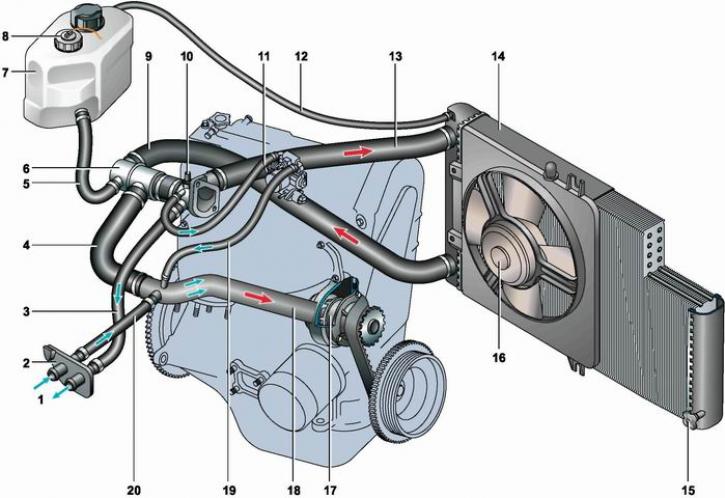The engine cooling system uses special liquids based on a mixture of water and ethylene glycol. They have a low freezing point and a high boiling point. In addition, thanks to the complex of added additives, the coolant prevents corrosion of the channel walls, does not foam, and prolongs the life of the coolant pump seal.

Cooling system: 1 - fluid circulation through the heater radiator; 2 - heater valve; 3 - hose for supplying coolant to the heater radiator; 4 - hose of the supply pipe of the coolant pump; 5 - expansion tank hose; 6 - thermostat; 7 - expansion tank; 8 - coolant level sensor in the expansion tank [Installed on some cars.]; 9 - hose for draining fluid from the engine radiator; 10 - coolant temperature sensor; 11 - hose for supplying fluid to the throttle assembly; 12 - steam outlet hose of the engine radiator; 13 - hose for supplying fluid to the engine radiator; 14 - engine radiator; 15 - radiator drain plug; 16 - electric fan radiator; 17 - coolant pump; 18 - inlet pipe of the coolant pump; 19 - coolant outlet hose from the throttle assembly; 20 - coolant outlet hose from the heater radiator
The circulation of fluid in the system is provided by a centrifugal pump installed in the cylinder block. The pump is driven by a toothed timing belt.
The liquid in the cooling system, depending on the temperature of the engine, can circulate both in a small and in a large circle. The thermostat controls the direction of fluid flow in the engine cooling system. It has two valves - main and bypass (additional). The main valve controls the circulation of liquid in a large circle, and the bypass valve in a small one. The valves are interconnected - when one opens, the second closes, and vice versa.
Cold bypass (additional) the thermostat valve is open and fluid circulates in a small circle through the cylinder block, cylinder head, throttle assembly and heater core. The heater radiator is built into the engine cooling system and is designed to heat the passenger compartment by circulating hot coolant through it.
At a temperature of about 87°C, the main valve of the thermostat begins to open, and the bypass valve closes, and for some time the liquid circulates in small and large circles at the same time. At a temperature of 102°C, the main thermostat valve is fully open, and the bypass valve is closed and the entire fluid flow passes through the engine radiator, where it is cooled by the oncoming air flow. If the air flow is insufficiently intense, the radiator is cooled by an electric fan. It is installed behind the engine radiator and is activated by a signal from the electronic engine control unit.
An expansion tank is installed in the cooling system to compensate for the thermal expansion of the liquid. Inlet and outlet safety valves are placed in the tank plug, which allows maintaining the optimum pressure in the system when the liquid is heated, as well as compensating for the vacuum when it cools.
